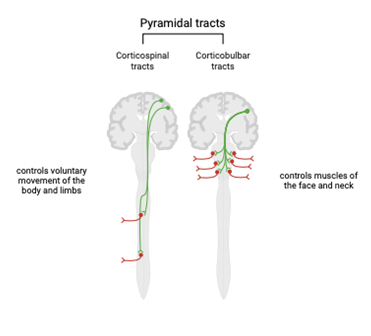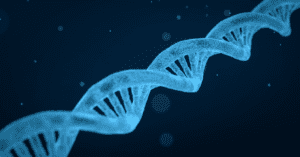
Have you ever wondered what part of your nervous system is helping move the muscles of your body? Or your head?
An important part of our central nervous system called the pyramidal tract is responsible for voluntary movements made by our body. The pyramidal tract is made up of two different tracts: the corticospinal and corticobulbar tracts. The corticospinal tract includes upper motor neurons that start in the cerebral cortex, which is part of the brain, and end in the spinal cord or brainstem. This allows neurons in the corticospinal tract to control voluntary movement of the body and limbs. The muscles of our face, head, and neck are controlled by the very similar corticobulbar tract. Nerves of this tract play important roles in swallowing, movement of the tongue, and in our facial expressions, among other things.
Damage to anywhere along the pyramidal tracts can cause a variety of issues, also known as pyramidal signs. Pyramidal signs include unusual tightness or stiffness of the muscles, or a feeling of “pulling” on the muscles. These symptoms are also known as spasticity. Increased muscle reflexes (hyperreflexia) and increased muscle tone (hypertonia) are also signs of damaged pyramidal tracts. People with affected pyramidal tracts can experience a loss of ability to perform fine movements and may experience involuntary, rhythmic muscle contractions also known as clonus. Pyramidal signs can also include symptoms such as weakness of lower parts of the face and changes to speech.
One of the hallmark signs of damaged pyramidal tracts is an abnormal plantar reflex, also called the Babinski sign. Neurologists test the plantar reflex by stimulating the sole of the foot with a blunt object. A normal plantar reflex involves the toes pointing downward, while an abnormal response (the Babinski sign) is noted by upward movement of the big toe. This upward response of the toe can help doctors to identify diseases of the spinal cord and brain, or recognize any damage caused to pyramidal tracts.

Image created by Asmer Aliyeva with Biorender.com
Snapshot Written by: Asmer Aliyeva
Edited by: David Bushart, MD
Read Other SCAsource Snapshot Articles

Snapshot: What is RFC1?
RFC1 is a gene that encodes for replication factor C subunit 1, a component of the protein replication factor C (RFC), which plays an important role in DNA synthesis. RFC Read More…

Snapshot: What is the Brief Ataxia Rating Scale (BARS)?
How do you accurately measure something as nuanced as coordination? For clinicians assessing ataxia, this question has driven the development of various rating scales. The Brief Ataxia Rating Scale is Read More…

Snapshot: ¿Qué es la Distonía?
La distonía es un trastorno que afecta a la forma en que una persona se mueve. Específicamente, las personas con distonía tienen contracciones musculares involuntarias, que pueden causar posturas de Read More…



